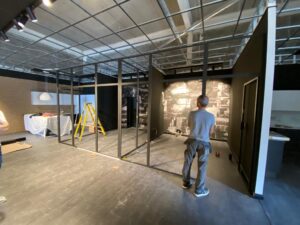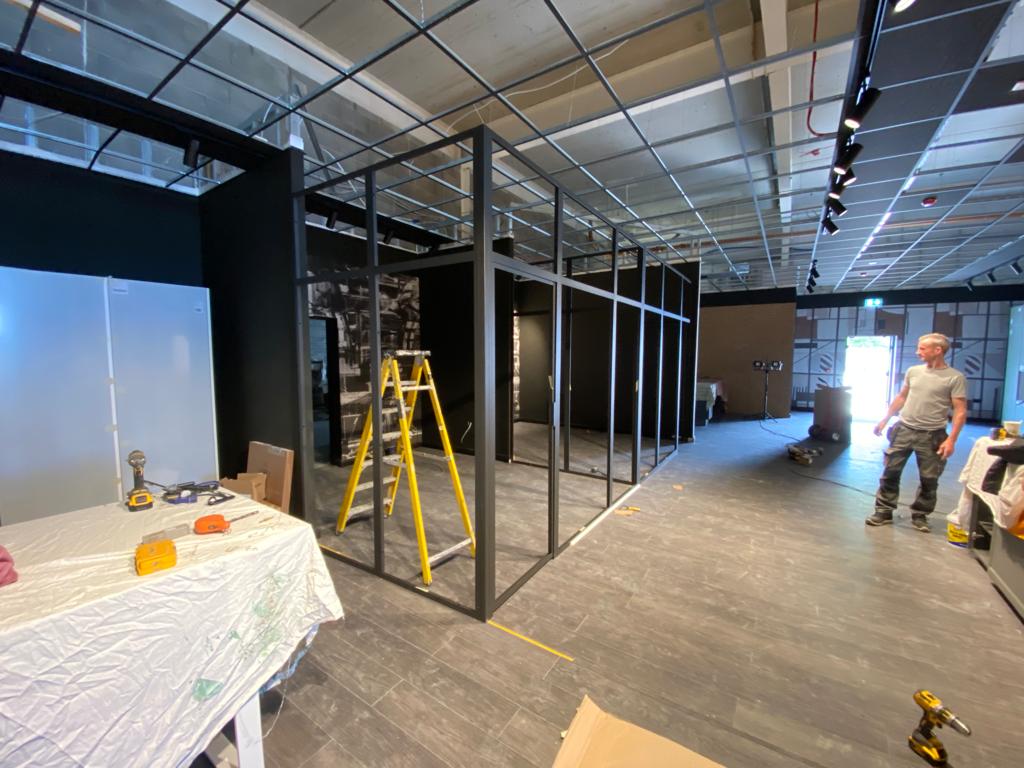If you are looking to outfit your shop or office floor with a new ceiling, then perhaps AR Construction can assist you.
As a collective of expert tradesmen AR Construction has been servicing the residential and commercial sectors of Limerick and Ireland for quite a few years.
We have designed, sourced and installed suspended ceilings for shop floors, office blocks, manufacturing bases and much more. We know what will work and what will not.
So, let’s delve in and see what the advantages and disadvantages are of having a suspended ceiling.
Suspended Ceilings
Suspended ceilings are also commonly called drop ceilings or false ceilings – and they are exactly what their various names imply.
These ceilings are suspended from the roof above, across the ceiling itself or other fixtures.
This creates a gap between the underside of the main structure and the top of the false ceiling. Many mechanics, office buildings, and technology labs utilise suspended ceilings.
Advantages of Suspended Ceilings
-
System Concealment
Suspended ceilings are known for their ability to conceal various system structures including pipes, ductwork, and wires. They can conceal minor imperfections and are an easy way to cover utility systems that require easy access.
-
Easy Installation
These handy ceilings can be installed with ease in both homes and commercial buildings. If you choose to have a suspended ceiling installed in an already used building, the disruption is minimal.
The AR Constriction team can work around your business schedule to ensure the work is complete with the minimum amount of interference.
-
Fire Protection
Suspended ceilings allow for the installation of several safety features, including sprinklers, alarm systems and much more.
These features are important, especially in work areas in which fires can be a hazard.
Provide the Arcon team with all the details of your business and we should be able to provide you with some safety features for your ceiling and business.
Disadvantages of Suspended Ceilings
-
Reduces Ceiling Height
One of the biggest drawbacks of suspended ceilings is that they make the room look smaller. Depending on the height of your ceiling and the room it’s in, your ceiling height may appear to be reduced by anywhere from a few inches to several feet.
The Arcon team will work to ensure your new ceiling is as aesthetically pleasing as possible whilst using the minimum amount of space required.
Exposed Ceilings
Known as open ceilings or open plenums, exposed ceilings leave the internal MEP and structural systems exposed. These structures may be painted or left in their natural colours.
These ceilings are popular in a variety of industries, most notably the architectural business.
Advantages of Exposed Ceilings
-
Adds Space to a Room
Exposed ceilings can do wonders to make even the most crowded or small room seem much more spacious, as the walls appear to be taller.
In addition, exposed ceilings allow hot air to rise away from occupants within the room, aiding in keeping rooms cool.
-
Potential for Natural Light
Exposed ceilings leave great potential for the use of natural lighting. They are ideal for the installation of skylights, which not only boosts the overall appearance of a space but also provides employees with a healthy dose of natural sunlight.
Disadvantages of Exposed Ceilings
-
Poor Sound Insulation
An exposed ceiling is almost certainly going to require acoustic treatment since they are unable to absorb the same amount of sound that suspended ceilings do. Exposed ceilings can easily create an echo chamber without treatment.
Making the right choice:
No matter which ceiling type you choose, working with Arcon is the best choice.
We can provide you with all the advice and assistance you need when choosing your ceiling.
Get in touch should you need a suspended ceiling or would like to know more about the ceiling options you have.
Contact the AR Construction team on 061 550 132 083 835 7426 or email: info@arconstruction.ie



